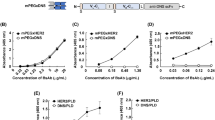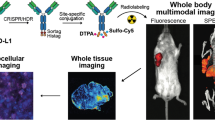Abstract
Purpose
Targeted theranostics is an alternative strategy in cancer management that aims to improve cancer detection and treatment simultaneously. This approach combines potent therapeutic and diagnostic agents with the specificity of different cell receptor ligands in one product. The success of antibody drug conjugates (ADCs) in clinical practice has encouraged the development of antibody theranostics conjugates (ATCs). However, the generation of homogeneous and pharmaceutically-acceptable ATCs remains a major challenge. The aim of this study is to detect and eliminate ovarian cancer cells on-demand using an ATC directed to EGFR.
Methods
An ATC with a defined drug-to-antibody ratio was generated by the site-directed conjugation of IRDye®700 to a self-labeling protein (SNAP-tag) fused to an EGFR-specific antibody fragment (scFv-425).
Results
In vitro and ex vivo imaging showed that the ATC based on scFv-425 is suitable for the highly specific detection of EGFR+ ovarian cancer cell, human tissues and ascites samples. The construct was also able to eliminate EGFR+ cells and human ascites cells with IC50 values of 45–66 nM and 40–90 nM, respectively.
Conclusion
Our experiments provide a framework to create a versatile technology platform for the development of ATCs for precise detection and treatment of ovarian cancer cells.






Similar content being viewed by others
Abbreviations
- ADC:
-
Antibody drug conjugate
- ATC:
-
Antibody theranostic conjugate
- EGFR:
-
Epidermal growth factor receptor
- FITC:
-
Fluorescein isothiocyanate
- ICG:
-
Indocyanine green
- NIR:
-
Near-infrared
- scFv:
-
Single-chain variable fragment
- SLN:
-
Sentinel lymph nodes
References
Vargas AN. Natural history of ovarian cancer. Ecancermedicalscience. 2014;8:465–75.
Coleman RL, Monk BJ, Sood AK, Herzog TJ. Latest research and clinical treatment of advanced-stage epithelial ovarian cancer. Nat Rev Clin Oncol. 2013;10:211–24.
Oliver KE, McGuire WP. Ovarian cancer and antiangiogenic therapy: Caveat Emptor. J Clin Oncol. 2014;32:3353–6.
Burger RA, Brady MF, Bookman MA, Fleming GF, Monk BJ, Huang H, et al. Incorporation of Bevacizumab in the primary treatment of ovarian cancer. N Engl J Med. 2011;365:2473–83.
Perren TJ, Swart AM, Pfisterer J, Ledermann JA, Pujade-Lauraine E, Kristensen G, et al. A Phase 3 trial of Bevacizumab in ovarian cancer. N Engl J Med. 2011;365:2484–96.
Lengyel E. Ovarian cancer development and metastasis. Am J Pathol. 2010;177:1053–64.
du Bois A, Reuss A, Pujade-Lauraine E, Harter P, Ray-Coquard I, Pfisterer J. Role of surgical outcome as prognostic factor in advanced epithelial ovarian cancer: a combined exploratory analysis of 3 prospectively randomized phase 3 multicenter trials. Cancer. 2009;115:1234–44.
Sato K, Hanaoka H, Watanabe R, Nakajima T, Choyke PL, Kobayashi H. Near infrared photoimmunotherapy in the treatment of disseminated peritoneal ovarian cancer. Mol Cancer Ther. 2015;14:141–50.
Spring BQ, Abu-Yousif AO, Palanisami A, Rizvi I, Zheng X, Mai Z, et al. Selective treatment and monitoring of disseminated cancer micrometastases in vivo using dual-function, activatable immunoconjugates. Proc Natl Acad Sci U S A. 2014;111:E933–42.
Strop P, Liu SH, Dorywalska M, Delaria K, Dushin RG, Tran TT, et al. Location matters: site of conjugation modulates stability and pharmacokinetics of antibody drug conjugates. Chem Biol. 2013;20:161–7.
Gronemeyer T, Chidley C, Juillerat A, Heinis C, Johnsson K. Directed evolution of O6-alkylguanine-DNA alkyltransferase for applications in protein labeling. Protein Engineering. Design Select. 2006;19:309–16.
Hussain AF, Amoury M, Barth S. SNAP-tag technology: a powerful tool for site specific conjugation of therapeutic and imaging agents. Curr Pharm Des. 2013;19:5437–42.
Hussain AF, Kampmeier F, von Felbert V, Merk HF, Tur MK, Barth S. SNAP-tag technology mediates site specific conjugation of antibody fragments with a photosensitizer and improves target specific phototoxicity in tumor cells. Bioconjug Chem. 2011;22:2487–95.
Hussain AF, Kruger HR, Kampmeier F, Weissbach T, Licha K, Kratz F, et al. Targeted delivery of dendritic polyglycerol-doxorubicin conjugates by scFv-SNAP fusion protein suppresses EGFR+ cancer cell growth. Biomacromolecules. 2013;14:2510–20.
Amoury M, Bauerschlag D, Zeppernick F, von Felbert V, Berges N, Di Fiore S et al. Photoimmunotheranostic agents for triple-negative breast cancer diagnosis and therapy that can be activated on demand. Oncotarget. 2016; 54925–36.
von Felbert V, Bauerschlag D, Maass N, Brautigam K, Meinhold-Heerlein I, Woitok M, et al. A specific photoimmunotheranostics agent to detect and eliminate skin cancer cells expressing EGFR. J Cancer Res Clin Oncol. 2016;142:1003–11.
Mitsunaga M, Nakajima T, Sano K, Choyke PL, Kobayashi H. Near-infrared theranostic photoimmunotherapy (PIT): repeated exposure of light enhances the effect of immunoconjugate. Bioconjug Chem. 2012;23:604–9.
Knutson S, Raja E, Bomgarden R, Nlend M, Chen A, Kalyanasundaram R. Development and evaluation of a fluorescent antibody-drug conjugate for molecular imaging and targeted therapy of pancreatic cancer. PLoS One. 2016;11:e0157762.
Sharma SK, Pourat J, Carlin S, Abdel-Atti D, Bankovich A, Sisodiya V, et al. A DLL3-targeted theranostic for small cell lung cancer: Imaging a low density target with a site-specifically modified radioimmunoconjugate. J Nucl Med. 2016;57:50.
Mitsunaga M, Nakajima T, Sano K, Kramer-Marek G, Choyke PL, Kobayashi H. Immediate in vivo target-specific cancer cell death after near infrared photoimmunotherapy. BMC Cancer. 2012;12:345.
Mitsunaga M, Ogawa M, Kosaka N, Rosenblum LT, Choyke PL, Kobayashi H. Cancer cell-selective in vivo near infrared photoimmunotherapy targeting specific membrane molecules. Nat Med. 2011;17:1685–91.
Kipps E, Tan DS, Kaye SB. Meeting the challenge of ascites in ovarian cancer: new avenues for therapy and research. Nat Rev Cancer. 2013;13:273–82.
van Dam GM, Themelis G, Crane LM, Harlaar NJ, Pleijhuis RG, Kelder W, et al. Intraoperative tumor-specific fluorescence imaging in ovarian cancer by folate receptor-alpha targeting: first in-human results. Nat Med. 2011;17:1315–9.
Tummers QR, Hoogstins CE, Gaarenstroom KN, de Kroon CD, van Poelgeest MI, Vuyk J et al. Intraoperative imaging of folate receptor alpha positive ovarian and breast cancer using the tumor specific agent EC17. Oncotarget. 2016: 32144–55.
Tummers QR, Hoogstins CE, Peters AA, de Kroon CD, Trimbos JB, van de Velde CJ, et al. The value of intraoperative near-infrared fluorescence imaging based on enhanced permeability and retention of indocyanine green: feasibility and false-positives in ovarian cancer. PLoS One. 2015;10:e0129766.
Cohen R, Stammes MA, de Roos IH, Stigter-van Walsum M, Visser GW, van Dongen GA. Inert coupling of IRDye800CW to monoclonal antibodies for clinical optical imaging of tumor targets. EJNMMI Res. 2011;1:31.
ACKNOWLEDGMENTS AND DISCLOSURES
The authors would like to thank Dr. Richard M Twyman for editing the manuscript. The authors declare that they have no conflict of interest.
Author information
Authors and Affiliations
Corresponding author
Additional information
Dirk Bauerschlag and Ivo Meinhold-Heerlein contributed equally to this work.
Rights and permissions
About this article
Cite this article
Bauerschlag, D., Meinhold-Heerlein, I., Maass, N. et al. Detection and Specific Elimination of EGFR+ Ovarian Cancer Cells Using a Near Infrared Photoimmunotheranostic Approach. Pharm Res 34, 696–703 (2017). https://doi.org/10.1007/s11095-017-2096-4
Received:
Accepted:
Published:
Issue Date:
DOI: https://doi.org/10.1007/s11095-017-2096-4




